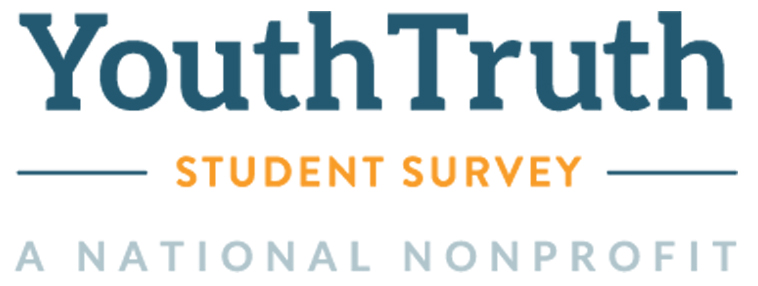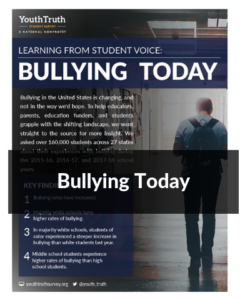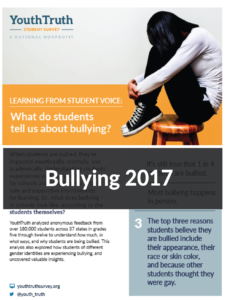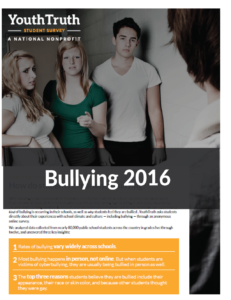Since 2016, YouthTruth has examined student perception data about bullying to contribute to anti-bullying conversations and action in honor of October’s National Bullying Prevention Month. In our most recent report, we analyzed feedback gathered over three academic years from more than 160,000 students across 27 states about their experiences with bullying. Here’s what we learned:
00
-
-
-
Bullying rates have increased.
-
Majority white schools have higher rates of bullying.
-
In majority white schools, students of color experienced a steeper increase
in bullying than white students in the 2017-18 school year. -
Middle school students experience higher rates of
bullying than high school students.
-
-
00
For more information about what students across the country have said through anonymous surveys in their schools – including insights about cyberbullying, and how students feel their race, gender identity, and sexual orientation contribute to why they are bullied – check out these reports:
What else can we do?
Through our direct survey work with schools and districts, as well as through our Learning from Student Voice series, YouthTruth has analyzed and reported on the unique insights about students’ experiences with bullying. As we’ve articulated local and national findings and shared links to resources, educators have asked, “Based on this sobering data, what is my next action?”
Anti-Bullying Resources
Teach Kindness
What it is
Teach Kindness is a 30-day challenge that uses research-based lessons to make kindness contagious in any school with grades K-8. A project of the national nonprofit, Stand for Children, the content on kindness-building comes from leading education organizations including Harvard’s Making Caring Common Initiative, InspireED, The Greater Good Science Center, and Yale’s Center for Emotional Intelligence.

How it works
- Accept the Challenge and sign up
- Complete a short reflection exercise with your team and then teach at least four lessons in four weeks
- Create a Kindness Ritual to make kindness routine at your school
Why we are fans
The intervention was initially designed for the environment that the data says needs it most: middle school. We know that middle school students are more likely than their older peers to experience bullying (in our most recent report nearly 40 percent of middle school students versus 27 percent of high school students), so it makes sense to target resources here. The lessons are also all grounded in rigorous research, and the online library of lessons is easy to navigate. Teach Kindness also offers specially curated content for younger students.
How to get started
Visit www.weteachkindness.org to register for the next challenge cycle.
Teaching Tolerance
How it works
Teaching Tolerance has tools for the classroom, whole schools, and entire districts.
- Classroom resources: lessons, texts, activities, teaching strategies, film kits, and printable posters
- Whole school resources: professional development tools for self-led workshops, workshop facilitation guides, expert-led trainings, webinars, and podcasts
- Whole district resources: frameworks with applicable systematic approaches to anti-bias, social justice, and civil rights education to make complex topics easier to understand, scale, and teach
Why we are fans
In our 2017 report, we found that when students who were bullied were asked why they thought they were bullied, 44 percent of students said it was because of how they look. The other leading reasons students believe they were bullied include their race or skin color (17 percent) and because other students thought they were gay (15 percent). Teaching Tolerance’s flexible collection of DIY resources gets to the heart of anti-bullying: promoting a culture of tolerance, respect, and the appreciation of differences. The tools help educators create structures of interventions and help prevent bullying from happening in the first place.
How to get started
Start exploring resources at www.tolerance.org.
What it is
We know that students of different identities and backgrounds experience bullying differently — revealing how bias can be connected to bullying. Teaching Tolerance is a project of the Southern Poverty Law Center and helps educators create more civil and inclusive school communities. By emphasizing social justice and anti-bias, Teaching Tolerance helps educators both create change and inspire students to become life-long agents of change.
What it is
By combining the study of human behavior with historical analysis, Facing History helps educators heighten students’ understanding of racism, religious intolerance, and prejudice. When students are able to relate history to their own lives, they become better agents in understanding their roles and responsibilities in their school communities and in society.
How it works
Facing History has created and curated a host of resources to help educators inspire their colleagues and students to become more active agents of change.
- Teaching strategies that integrate history and literature with ethical decision-making
- Educator resources including multimedia materials, primary sources, streaming videos and full units
- An on-demand learning center and expert-led events for educator professional development
Why we are fans
Facing History is committed to ending bigotry and hatred globally, and there’s a reason they’ve focused on students, teachers, and schools. In Learning from Student Voice: Bullying Today, we shared that 33 percent of students had experienced bullying. That’s 1 in 3 students, up from 1 in 4 students just a few years prior. There has never been a better time to promote students’ historical understanding, critical thinking, and social-emotional learning to help students engage with the power they have to make a positive difference in their lives, as well as the lives of their peers.
How to get started
View and download free resources, subscribe to the blog, or find a workshop or seminar near you at www.facinghistory.org.
What it is
GLSEN — pronounced “glisten” — is committed to improving the experiences of LGBTQ students in school so that they can learn and grow in a school environment free from bullying and harassment.
How it works
GLSEN resources help adults discuss bullying, gender roles, and family diversity across student ages, include positive representations of LGBTQ people in the curriculum, and inspire students to speak up when they see bullying.
- Explore LGBTQ-Inclusive and Bullying, Bias & Diversity lesson plans
- Check out GLSEN toolkits, then watch a webinar or two for in-depth exploration of a particular topic
- Join GLSEN’s Educator Network and receive monthly emails that highlight GLSEN’s resources and provide up-to-date information on GLSEN research
Why we are fans
The YouthTruth data show that when controlling for other student demographic characteristics, students who identify in a way other than male or female are twice as likely to be bullied than their peers. Additionally, of students who are bullied, students who identify as other than male or female are also three times as likely to be bullied physically and 4.6 times as likely to be bullied because other students thought they were gay, whether or not they identified as such. GLSEN provides resources that help educators make schools safe and affirming environments for all, regardless of sexual orientation, gender identity, or gender expression.
How to get started
Explore www.glsen.org to join their Educator Network.
YouthTruth Partner School Spotlight
What’s their story?
When the Quincy Junior High team in Washington State reflected on their YouthTruth survey data in year three of surveying, they saw a dramatic increase in bullying. “This was not data that could be ignored,” shared Principal Scott Ramsey. The percentage of students who reported being a victim of bullying had jumped from 28 percent in the previous two years, to 46 percent.
The school identified this area as a priority for change and designed targeted interventions. In the next year of survey data, the proportion of students who reported being bullied dropped down to 36 percent.
What they did
- Gathered data. Quincy administers YouthTruth surveys annually. The valid, reliable, and anonymous climate surveys include questions about peer belonging and bullying with data tracked over time. The consistent, annual feedback made it possible for staff to measurably observe the increase, and subsequent decrease, in bullying.
- Reflected on the findings. Each year the team began the data reflection process by unpacking the findings together in staff meetings. The data helped create a common understanding of the problem. In response to year three data, they launched an anti-bullying initiative, including a two-day lesson plan that engaged students and teachers across the whole school.
- Engaged students. The two-day lesson plan engaged students across all classes, and inspired an 8th grade class to create a video that was featured by a local news station. Click here to watch the three-minute news coverage, or watch the full five-minute video here.
What we like about it
So much can be learned when adults not only ask students about their experiences, but also listen deeply and react promptly to what they’ve heard. Listening to students is the first step in generating the awareness, discussion, and action necessary to address bullying.
How to get started
- If you already have YouthTruth data, check out the two-day lesson plan here.
- To bring YouthTruth to your community, visit www.youthtruthsurvey.org/get-started.
From Research to Practice
What does the research say?
To help build and share knowledge as school teams collaboratively create interventions, here are a few great pieces of research that are worth the read.
#bullyingresearch
Benbenishty, R., & Astor, R. A. (in press). “Proposed policies to reduce weapons in schools:
Based on research from an ecological conceptual model.”
Oxford Handbook of Children and the Law Chapters. 2018. New York: Oxford University Press..
~30 min read. Why read it?
Ron Avi Astor and Rami Benbenisthty are among the foremost researchers on violence prevention in schools. In their chapter in the upcoming Oxford Handbook of Children and the Law, they demonstrate that in addition to a positive school climate, a cohesive school staff that communicates regularly to share critical information can mitigate violence and bullying. As Astor and Benbenisthty also point out, educators are wise to explicitly cultivate student voice as an anti-bullying asset so that “upstanders” will trust adults and speak out when they have a concern. Astor and Benbenisthty also urge adults to work alongside students to map the physical environment of the school to identify and address dangerous spaces.
American Educational Research Association Task Force. “Prevention of Bullying in Schools,
Colleges, and Universities.”
American Educational Research Association. 2013. Washington, DC; AERA.
~30 min read. Why read it?
An expert Task Force on the Prevention of Bullying, representing the nation’s largest educational research association, summarized the research on bullying to highlight characteristics of schools with less bullying. In addition to stressing the importance of teaching pro-social behaviors, this group of leading experts detailed the critical role of school culture, highlight in particular the two key ingredients in schools with less bullying: 1) a clear disciplinary structure, and 2) strong adult supports for all groups of students. As the Task Force recommended, a crucial step in building a pro-social culture begins with assessing your school’s strengths and needs in a way that is comprehensive, reliable, and valid.
Cornell, Dewey, and Limber, P. Susan. “Law and Policy on the Concept of Bullying at School.”
American Psychologist, May-June, 2015. 333-343.
~30 min read. Why read it?
Dewey Cornell and Susan P. Limber draw from 75 legal and scholarly papers as they make the case that “education is a right and bullying is an impediment to that right.” Here you’ll find legal and practical definitions of bullying, as well as how bullying is substantively different than “harassment.” Especially interesting is a brief discussion of the challenges to clearly identify the power imbalance between children, a necessary criterion. Since most bullying is social and verbal, assessing power imbalance between aggressor and victim is not always obvious. The authors conclude by sharing a list of recommendations for shaping anti-bullying policies to meet legal requirements and reflect best practices.
Want more? Explore more research at youthtruthsurvey.org/resources/#research.
Sample Discussion Questions
- In what ways have you observed bullying as an issue at our school? How might these or other resources help more students feel welcomed, included, and accepted at our school?
- Are all adults aware of the anti-bullying initiatives in place on our campus? How effective do you think they are? Have they incorporated student perspectives?
- What is one take-away that you have after reading one of the pieces of research linked above in From Research to Practice?
- What is one action you will take to help decrease bullying at your school? Share your action on Twitter @Youth_Truth using #antibullying.
- How much of a problem do you think bullying is in our school?
- Do you know where students can go to get help if they are being bullied? Do you think students feel comfortable using those resources? Do you have suggestions for how to improve those resources?
- What are you doing to combat bullying at our school?
- What questions or suggestions do you have for our school’s leaders and teachers to help address bullying?
Commit to one action you will take to help decrease bullying at your school.
What will it be? Tell us about the action you’re taking at @Youth_Truth using #antibullying.Section 1
DOWNLOAD THIS GUIDEBOOK
Want to learn more about how you can gather student feedback to drive improvements in your school or district?











